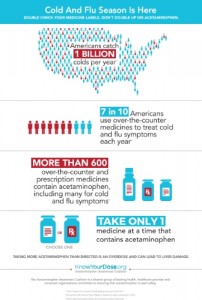 With cold and flu season around the corner, consumers will soon begin to purchase medicines such as cough syrup, throat lozenges, and nasal sprays to help get relief from symptoms such as fever, coughs, congestion, and more. Many of the medicines used to treat these cold and flu symptoms can contain common drug ingredients such as acetaminophen.
With cold and flu season around the corner, consumers will soon begin to purchase medicines such as cough syrup, throat lozenges, and nasal sprays to help get relief from symptoms such as fever, coughs, congestion, and more. Many of the medicines used to treat these cold and flu symptoms can contain common drug ingredients such as acetaminophen.
Research published this year shows that consumers don’t always know the potential risks of double dosing on medicine or that taking two medicines with the same ingredient could be harmful. That’s why the Acetaminophen Awareness Coalition(AAC) is issuing a safety message to consumers, reminding them to double check their medicine labels to avoid doubling up on medicines with acetaminophen when treating symptoms during the upcoming cold and flu season.
Acetaminophen is found in more than 600 over-the-counter (OTC) and prescription medicines, including many that treat cough, cold, and flu symptoms. It’s safe and effective when used as directed, but there is a limit to how much can be taken in one day. Taking more than directed is an overdose and can lead to liver damage. The U.S. Food and Drug Administration has set a maximum daily dose of 4,000 milligrams of acetaminophen in a 24-hour period.
The Coalition advises cold and flu sufferers to follow four key acetaminophen safe use steps:
- Always read and follow the medicine label.
- Check the labels on all of your medicines for acetaminophen, which is listed on the front panel of packaging and in bold type or highlighted in the “active ingredients” section of OTC medicine labels, and sometimes listed as “APAP” or “acetam” on prescription labels.
- Take only one medicine at a time that contains acetaminophen.
- Ask your healthcare provider if you have questions about dosing instructions or medicines that contain acetaminophen.
The Acetaminophen Awareness Coalition, a diverse group of leading health, healthcare provider, and consumer organizations, formed the Know Your Dose campaign to educate consumers about safe acetaminophen use in order to prevent liver damage.
For more information, visit www.KnowYourDose.org and follow @KnowYourDose on Twitter.
